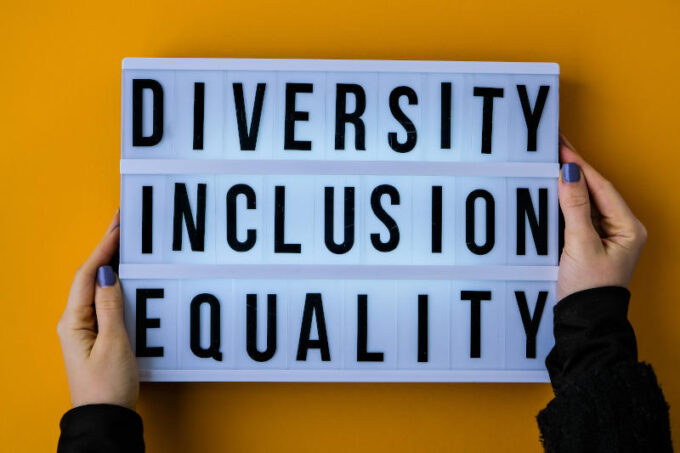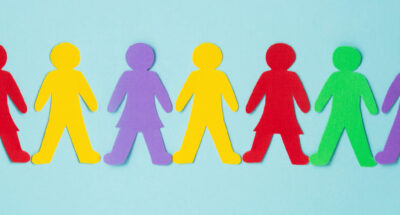
Speaking up and staying strategic
When talk of diversity triggers backlash, leaders face a paradox: how to advance inclusion goals while choosing language that keeps dialogue alive in hostile environments....

by Karen Lee Ashcraft, Sara Louise Muhr Published June 11, 2025 in Diversity, Equity, and Inclusion • 12 min read
All this global destabilization rattles the institutions we rely on yet take for granted.
It is difficult to dispute that we live in a “polycrisis,” a prescient term coined by French thinkers Edgar Morin and Anne-Brigitte Kern back in the 1990s. Climate disasters, global pandemics, skyrocketing economic inequality, intensifying immigration flows, unchecked artificial intelligence and surveillance, widespread sociopolitical unrest, flagging democracies, rising far-right nationalism and rule by oligarchy, escalating militarization, war, and genocide – and this is an incomplete list. As troubles like these collide and compound, only one thing is certain: profound uncertainty is the new normal.
All this global destabilization rattles the institutions we rely on yet take for granted. It is no surprise, then, that the backbone democratic values of diversity, equity, and inclusion (DE&I) have found their way into the crosshairs of the “anti-woke” crowd. DE&I, an acronym originally intended as shorthand for programs that try to practice these values, has now been smeared as a sinister plot against the very values such programs hold dear. Thanks to rampant insecurities stoked by the polycrisis, this smear campaign appears to be working. Organizational leaders around the globe are feeling the fear and rolling back DE&I initiatives as we type.
Here, we seek to dispel the myths spread by the anti-DE&I movement and consider the serious consequences for organizations and societies if DE&I is diminished or, worse, abolished. We contend that DE&I must be reclaimed and reinvented instead. Done well, DE&I is one of few practices that can help us respond collectively – and effectively – to extreme uncertainty. As it turns out, polycrisis is driving the demise of DE&I at precisely the moment we need it the most to navigate through uncertain times. In other words, DE&I is a leader’s best hope to help us weather the unknown together.

“For now, try pausing for a moment to consider the opposite of diversity, equity, and inclusion: namely, sameness, inequity, and exclusion.”
Misusing the name of meritocracy, the anti-DE&I wave originating in the US is sweeping through Europe with stunning speed and force. Programs and personnel who increase diversity among employees and enhance inclusion at work are swiftly getting the axe, while words like “equity,” “women,” and “LGBTQ” are getting scrubbed from policies and annual reports, ironically under the banner of anti-discrimination. Of course, the case for meritocracy is strong for any business leader concerned with competitive advantage. What is weak is the case that DE&I obstructs meritocracy and furthers favoritism. This is a gross (and, in some cases, willful) misread of DE&I’s intent, which adheres to bedrock principles of embracing difference and fairness for all. More on this later.
For now, try pausing for a moment to consider the opposite of diversity, equity, and inclusion: namely, sameness, inequity, and exclusion. Now ask yourself, do these counter-democratic values pave the way for meritocracy; do they prevent discrimination? Obviously not; they hinder meritocracy and promote discrimination. Yet we are urged to harbor suspicion of diversity, equity, and inclusion when it is the “anti-woke” repudiation of these vital human values that should make us sweat. What world do they hope for, anyway? That’s a longer conversation, but what we can say now is that it is not one most of us want to live in. If you, like us, want a world where everyone can thrive, where people co-exist and act together across their differences, then DE&I is for you. In truth, it is for all of us.
If we abandon diversity, equity, and inclusion, make no mistake: we will see organizations become increasingly homogeneous which, frankly, is good for no one. We know from research in multiple fields that, despite our best intentions, our brains operate through bias. Because our brain cannot process all the information flowing in, it helps us cut through overload and make decisions by creating shortcuts. One of the most pronounced is similarity bias, which predisposes us to favor what feels familiar, or readily recognizable, to us – for example, when it comes to hiring and promoting, or evaluating candidate competencies.
Put simply, if we don’t proactively encourage opening to difference, we default to the ease of sameness. This natural human habit has been exacerbated by personal devices, algorithmic feeds, and social media bubbles that drown us even deeper into sameness. By now it is commonplace to decry the resulting polarization that has swept over organizations and societies. Indeed, DE&I now stands accused of worsening this predicament. We are not here to defend all programs operating under the DE&I label. No doubt some go awry and contribute to further division, and of course, we too want to stop this. But the bottom line is that without some kind of conscious DE&I practice, people and organizations fall back on the comforts of sameness. They lack the crucial capacity to welcome and work across differences – a capacity that is even more urgent if we hope to confront the polycrisis.
Notice how the bottom is already dropping out of the “anti-woke” indictment of DE&I and the topsy-turvy world it would have you believe exists. Yet we have barely scratched the surface of the “D” in DE&I. Next, we take each letter of the acronym in turn for a fuller debunking. Our goal is not to fight with “anti-wokers.” Who needs more polarization, after all? We sincerely welcome them on board if they too are enticed by the ensuing description of DE&I that helps everyone thrive. Our goal, therefore, is twofold: (1) To reclaim the label DE&I for the actual values it stands for, and (2) to stimulate efforts to reinvent DE&I as a powerful leadership tool for cultivating the collective agility whereby we can face the polycrisis, together.
A wealth of research shows that fostering diverse teams and perspectives enhances creativity, improves decision-making, reduces mistakes, and expands the appeal of products and services.
There is still more to say about that “D” for diversity. The reason we think leaders will agree on the importance of embracing difference is simple: A wealth of research shows that fostering diverse teams and perspectives enhances creativity, improves decision-making, reduces mistakes, and expands the appeal of products and services – to name only a few benefits.
DE&I’s detractors ignore such proven gains in favor of spreading slurs (like “DE&I puts diversity over merit”) and sowing fear (of incompetent “DE&I hires”). Drill down and you will find these anxiety-boosting tactics and images to be the oldest tricks in the book, based on anecdotes gone wild and exceptions-to-the-rule rather than systematic study. Indeed, this is the “anti-woke” strategy: simply plant fertile feelings of doubt. Observe for yourself how little interest they show in reviewing the evidence. Why bother learning the finer points, when you can spread enough suspicion that no one dares to look closely?
Dear leaders, you can be those bold souls who look closely. How does DE&I serve, not obstruct, the principle of merit? By blocking the biases that rule out countless competent candidates who do not make it past our less conscious shortcuts. Similarity bias, described earlier, is one of many. There is also proximity bias, for example, when we draw on recent or frequent time spent with people to prioritize them for opportunities. Or intuition bias, that ‘sixth sense’ whispering in your ear that you know things – say, about certain types of people – that you do not. We may follow our instinct that someone doesn’t “fit the mold,” without realizing how expanding that narrow box could allow more people and, thus, the company to excel. DE&I is about ensuring that a diverse talent pool can not only find your organization but find it interesting, welcoming, legible, maneuverable, and rewarding – a community where they too can be seen, belong, make their mark, and want to stay. Far from scary, “DE&I hires” like this enrich the organization.
“E” is for equity, the equally important fairness part mentioned earlier. Simply opening to difference after years of not doing so is not enough to activate fairness. Over time, bias works its way into organizational and societal systems, like the structures we create (divisions of labor, hierarchies of value) the practices we repeat (“how things are done around here”), and the cultural norms we enforce (what is perceived as ‘normal’ and ‘weird’). To enable true equal opportunity, we must tend to those official and unofficial systems that, however unwittingly, maintain inequality.
To be sure, diagnosing and dismantling these systems is a difficult and nuanced enterprise that requires deep expertise and care. No surprise, then, if some programs still falter here. Should we abandon fairness because it is hard to achieve? Since when do glitches along the way to solving wicked problems invalidate the whole enterprise? Who would advise leaders and organizations to give up on a challenge so easily? So it should be with DE&I.
The industry standard is clear. Contrary to “anti-woke” accusations, equity unequivocally does not mean favoritism for some identity categories at the expense of standards or quality. Smart approaches to equity are tailored. They investigate which biases are in play in any given context and how exactly these are shaping organizational systems, such as recruitment, hiring, evaluation, promotion, and retention. Based on comprehensive analysis, they make strategic adjustments to structure, practice, and culture to stem the tide of bias and breed new habits of equity. The guiding question is not so much “How do we go and get more diversity?” but, rather, “What is it about our organization already that prevents us from attracting and sustaining diversity?” The guiding rule: Fix the system, not the person deemed ‘different.’
This brings us to the “I” for inclusion. The blunt truth is that in the absence of meaningful inclusion, diversity may well increase conflict, and equity can give rise to resentment. Essentially, inclusion is a safe container that ‘holds’ everyone. It fosters a sense of security – a kind of fundamental ‘OK-ness’ – for all members, both dominant and marginalized, on the road to transformation. As this suggests, safety does not mean that we won’t be asked to take risks or challenged to change. It means that there is space for us to be ourselves, feel seen and heard, disagree and know we can survive it, make and mend mistakes, and try and try again.
Inclusion is what gives everyone access to support and to thrive, even when things get hard. It is not only about including certain kinds of people who were once excluded. This is key. The call ‘to be inclusive’ asks us to shift focus from who is to be included (the excluded) to the includer (those who seek to stop excluding). At first, this may seem to defeat the purpose but go with us one level deeper. If you attempt to include by making space for an excluded “other,” there is already a power distance in play: you, positioned as a benevolent host, invite the guest inside and do them the honor (favor?) of tolerating the difference made by their presence. What if, instead, you turn this relationship around and ask, “What might I have missed all along by not including “others”? (How) is my being, experience, knowledge, and even joy suffering from their exclusion? What must I let go of – or open up to – to heal these limitations?” In this way, inclusion holds the possibility to expand everyone’s horizon of potential by enriching our connectedness.
In the end, there is no way around it: If leaders want to reap the benefits of diversity, they must dedicate themselves to equity and inclusion as well. D, E, and I, together, are defined as the capacity to relate and organize ethically across complex differences. Now, can you imagine a skill that will be more essential as the global polycrisis unfolds?

Once we reclaim DE&I in this way – as the capacity for collective care and action across differences – the mandate becomes clear: DE&I is precisely what we need to cope with the world ahead. Think about it:
If you don’t see the appeal and necessity of each element for facing up to the polycrisis, perhaps your bet is on a private bunker instead. Of course, we jest, and it is no joke: the rest of us sorely need the ties only diversity, equity, and inclusion can provide.
It is not hyperbole to say that DE&I is the leadership challenge of our time. Bold leaders with real foresight must stand up for DE&I to help their organizations join hands as they venture into the unknown. Don’t get us wrong; we are not so naïve as to think companies will save the world, but we do believe they can play a crucial role. Business leaders in particular have the capacity – especially when they band together – to counter the anti-DE&I movement’s smear-and-fear campaign with the compelling truth. Which is that organizations need diversity, equity, and inclusion to deal with the extreme uncertainty ahead.
We harbor no illusions that standing up will be easy. Capitulating to “anti-woke” demands and rolling back DE&I is the path of least resistance today. But there is no courage in falling back on “how it used to be” or “what is natural” as a justification for returning to old hierarchies that secure the status and power of a privileged few by barring so many competent contributors. Sameness, Inequity, and Exclusion? Supremacies like this do damage to everyone, including their alleged beneficiaries.
Leadership and courage are old friends who need each other once again to meet this historical moment. Step one: Stand up to the DE&I bullies and bans. Reclaim DE&I for what it is and insist that it is mission-critical. Step two: Lead by example. Open yourself to hard conversations that require facing your biases and anxieties. Every day, we work with leaders who model the strength of vulnerability, building DE&I capacity to level up their leadership.
Dear leaders, take a deep breath and ask yourself: Do the DE&I programs you have underway really conflict with meritocracy and anti-discrimination? If so, we agree that you need new ones.
If not, we urge you not to rename, minimize, or drop them. We have laid out here (only some of) the grave consequences of bidding goodbye to DE&I. Boiled down, it offers the relational equipment needed to meet the global polycrisis together. It is a leader’s best hope to brace their organization for the unknown.
Diversity, equity, and inclusion are worth fighting for. They will help us sleep at night and hold on tight while we fight for a world worth keeping.

Professor of Communication at the University of Colorado Boulder
Karen Lee Ashcraft is Professor of Communication at the University of Colorado Boulder (USA) whose extensive published research examines the organizational and cultural politics of difference. Her most recent book, Wronged and Dangerous (2022, Bristol UP), reveals how a form of masculinity went viral and powered the global rise of the far right.

Professor of Diversity & Leadership at the Department of Business Humanities and Law at Copenhagen Business School
Sara Louise Muhr is a Professor of Diversity & Leadership in Copenhagen Business School’s Department of Business Humanities and Law. Her research focuses on critical perspectives on managerial identity, leadership, and human resources management, including navigating diversity and expectations towards employees and leaders in flexible work environments. Sara’s work has materialized in more than 80 published books and journal articles. Her most recent books are How to fight everyday discrimination and Leading through bias, co-authored with Poornima Luthra.

October 21, 2025 • by Vanina Farber in Diversity, Equity, and Inclusion
When talk of diversity triggers backlash, leaders face a paradox: how to advance inclusion goals while choosing language that keeps dialogue alive in hostile environments....

August 20, 2025 • by Francesca Annalisa Petrella, Fernando Alonso Pérez-Chao, Luca Condosta in Diversity, Equity, and Inclusion
While support for workplace LGBTQ+ programs has dropped to just 38% globally, cities with strong inclusion policies demonstrate four times higher human capital performance and double the innovation scores than their less...

July 11, 2025 • by Silke Mischke in Diversity, Equity, and Inclusion
While some organizations retreat from inclusion commitments under political pressure, the path to lasting transformation lies in embedding diversity deeply within core values rather than treating it as a compliance issue. Leaders...

June 30, 2025 • by Misiek Piskorski, Alexander Fleischmann in Diversity, Equity, and Inclusion
As Pride Month celebrations fade, sobering data reveals the persistent workplace challenges facing LGBTQ+ employees globally. From the ‘gay glass ceiling’ blocking executive advancement to six in 10 LGBTQ+ Europeans hiding their...
Explore first person business intelligence from top minds curated for a global executive audience